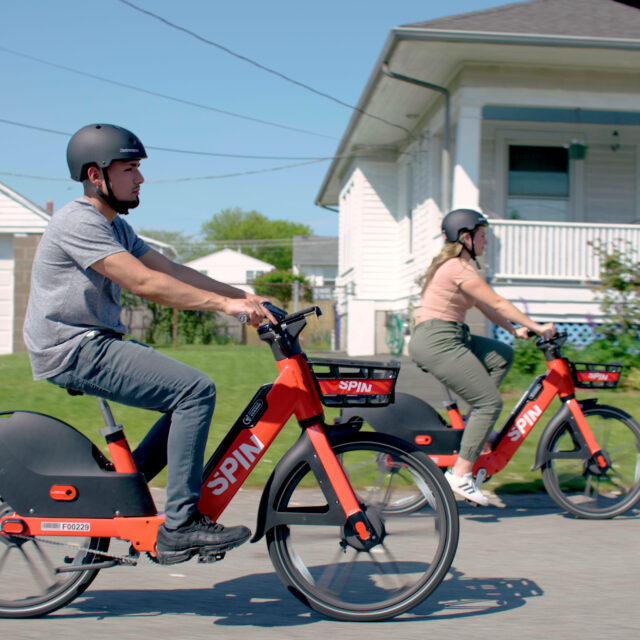Seattle’s Shared Micromobility Evolution
by Kiran Herbert, Communications Manager
January 21, 2022
The Emerald City was a pioneer when it came to bike share — here’s how its offerings have changed over the years, along with some potent lessons learned along the way.
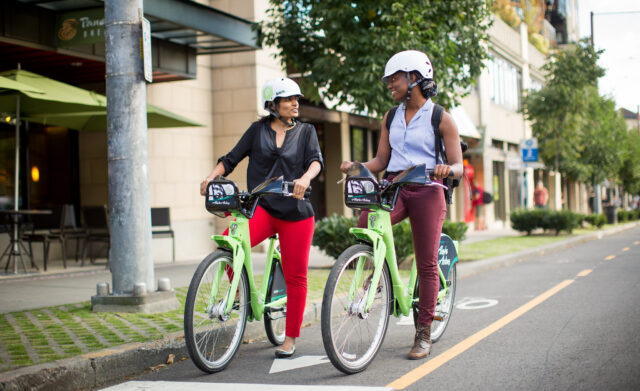
Seattle’s station-based bike share system, Pronto Cycle Share, lasted just three years.
In October 2014, when Pronto Cycle Share first hit the streets of Seattle, it was still the early days of bike share and the city was among the first to get a system off the ground. Just three years later, however, the system was disbanded. The introduction of dockless bikes came next — Seattle was the first city in the U.S. to allow them — followed eventually by dockless electric-assist bikes and electric scooters. Recently, Seattle announced that Chicago-based Veo would launch operations locally, bringing 1,500 more e-bikes to city streets by spring.
Reflecting on what the move might mean from an equity perspective, we spoke with Becky Edmonds, shared mobility program manager at the Seattle Department of Transportation (SDOT), as well as Joel Miller, who was the SDOT’s bike share program manager from 2017 to 2020 (today, he serves as the department’s program development supervisor of public space management). We discussed the history of shared micromobility in Seattle and where the city stands today — as well as some potent lessons learned along the way.
The Beginnings of Seattle Bike Share
With 50 stations and some 500 bikes, Pronto was mostly concentrated in Seattle’s downtown core. As noted above, the system lasted from the fall of 2014 to the spring of 2017 and was initially managed by a nonprofit and operated by the private company Motivate (Alaska Airlines served as the main corporate sponsor). From the get-go, ridership on Pronto lagged, with most bikes being ridden less than once a day, on average, from October 2014 to October 2015. Then, a planned expansion — which would have added 60 stations and 600 bikes — was delayed. In March 2016, SDOT bought the system but by this time it was already insolvent.
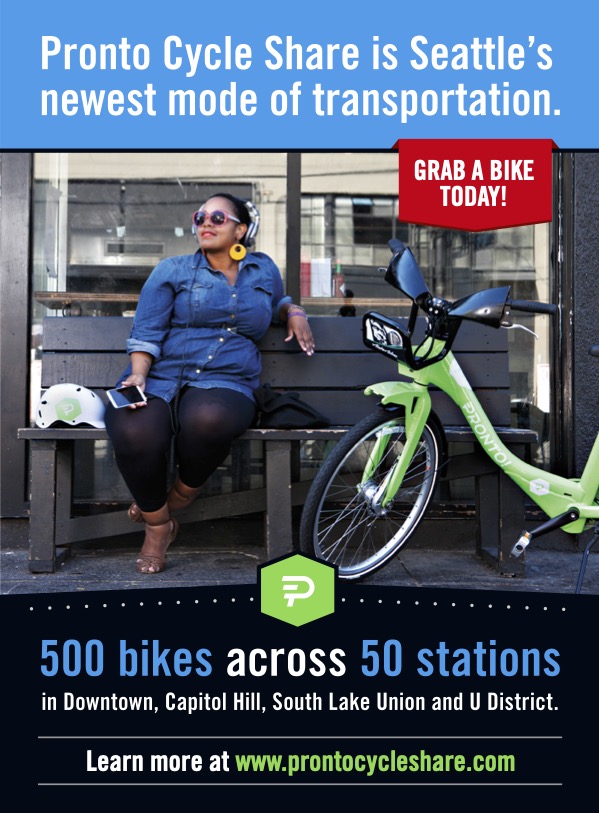
Marketing material from the era of Pronto Cycle Share.
“There was an idea to really invest in the system and expand it with the ethos of public transportation behind it,” says Miller, noting that newspaper headlines and the general rigmarole of politics complicated things. “City leaders quickly backed off from that plan.”
It was generally understood that, for the system to be successful going forward, it would need to expand into more neighborhoods. New light rail stations also opened in downtown, easily replacing the trips you could do with a Pronto bike, which were heavy and difficult to navigate on the hilly downtown terrain.
“Even as someone who wanted to use it, it wasn’t easy and I probably only used it some three or four times,” says Edmonds, adding that Pronto had a poor user experience and a limited service area. “You’d have to walk five or six blocks, get a bike, find a flat route, ride 10 to 15 blocks, park it at a station, and then probably walk another four to five blocks to wherever you were going.”
Edmonds says that one of the coolest things about Pronto was its method of ensuring every rider had access to a helmet. In King County, which includes Seattle, an unjust bicycle helmet law requires that all cyclists wear helmets and to address it, the system installed helmet dispensers at each kiosk, alongside a collection bin for used helmets. At first, they were available for free on the honor system, although eventually, a rental system went into effect.
While it was a shock for many to see the system eventually abandoned in March 2017 (the bikes were offered up to other cities), there were some significant takeaways from this era of Seattle shared micromobility history: Bike systems that are confined to a small area aren’t useful, sustainable, or equitable, the city’s hills were prohibitive for casual riders, there was little political appetite for a city-owned and operated system, and finding sidewalk and curb space for stations was a problem (and elicited a lot of complaints).

Lime, Spin, and Ofo were among the first dockless bike vendors to launch in Seattle.
Introducing Dockless Mobility Options
Four months after Pronto shut down, Seattle became the first U.S. city to welcome dockless bike share. China had just experienced a boom in free-floating bikes, but most American cities had exclusivity agreements with their bike systems. Miller tells of how his predecessor wrote the nation’s first bike share permit in a two-month sprint and the system launched soon after. Each company that came on — Spin, Lime, Ofo, and eventually Uber-owned Jump — had its own permit, which, in a big departure from Pronto, required them to operate citywide.
“One of the interesting things from the first two months was that the bikes naturally spread out on their own,” says Miller. “The operators didn’t have all the data that they have now for rebalancing, where to look at more rides, where to get more profitability and things like that. What the city really saw quickly was that people wanted to use these bikes everywhere — it was very organic.”
City officials began hearing that bikes were showing up in communities in south Seattle that were predominantly BIPOC because residents were riding them there (a BBSP-supported Drexel University study found that dockless bikes did indeed result in spatial equity in Seattle). Miller believes that there was more buy-in in these communities because the city wasn’t coming in and forcing bike share on people (although good community engagement could have counteracted that). The spread of bikes into those neighborhoods also led to many conversations with police about the need to not racially profile riders — BIPOC riding these bikes often solicited unwanted interactions, especially if they weren’t wearing helmets.
Although in the early days more than a few bikes ended up in the water, the dockless model proved to be a good fit for residents. However, for most of the early operators, Seattle was ultimately not a viable market: By 2019, the city was down to just one vendor, Lime, who was using old Jump bikes after Uber sold the company. Ofo left citing high fees, as did Spin, which wanted provisions for electric scooters. From a programmatic perspective, SDOT continued to evaluate things, changing permit requirements to add clauses and accommodate the growth of electric bikes. In 2020, the city changed regulations once again to allow electric scooters.
“We really just focused on iterating and growing our program to meet where technology was, as well as where it wasn’t,” says Miller.
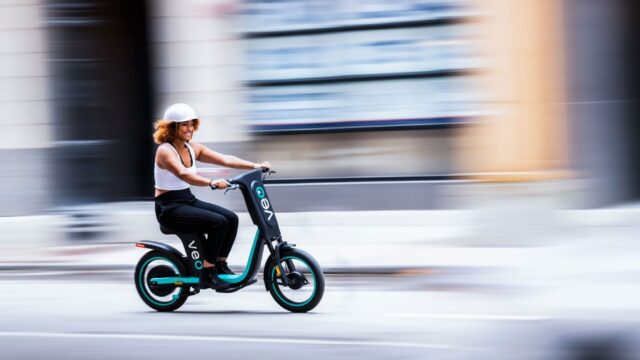
Veo, Seattle’s newest bike share vendor, will bring 1,500 more e-bikes to city streets by spring.
Seattle’s Shared Micromobility Scene Today
A 2019 study out of the University of Washington surveyed Seattle bike riders, combing through press reports, analyzing ridership data, and interviewing experts involved in both Pronto and dockless bike sharing in Seattle to determine why the former failed and the latter succeeded. What the researchers found:
- Pronto’s footprint was limited. Many neighborhoods that now have high dockless ridership did not have Pronto docking stations at all.
- Pronto had a smaller number of bikes per square mile. When dockless bike sharing was introduced, the number of bike share bikes in Seattle grew from 500 to 9,000 by the end of the first year, and the footprint expanded from 5 square miles to 84.
- Pronto was perceived as “moderately difficult” to use, whereas people found the dockless system easy to use.
- Pronto was more expensive for short rides — $8 per day with no per-ride option — compared to dockless bikes, which cost about $1 to unlock and then charged a per minute rate (anything from 15 to 36 cents) with low-income options.
Today, there are four scooter vendors operating in Seattle (including Spin, which returned without bikes), and two bike vendors, Lime and the newly introduced Veo, whose bike design is moped-esque, making it easier for riders of varying body types and physical abilities to ride more comfortably. Since 2019, there have been approximately 12 million total miles traveled on bike and scooter in Seattle (the equivalent of circumnavigating the Earth 482 times). The city has also invested heavily in its bike network, building out more protected bike lanes and infrastructure aimed at facilitating bike to transit connections.
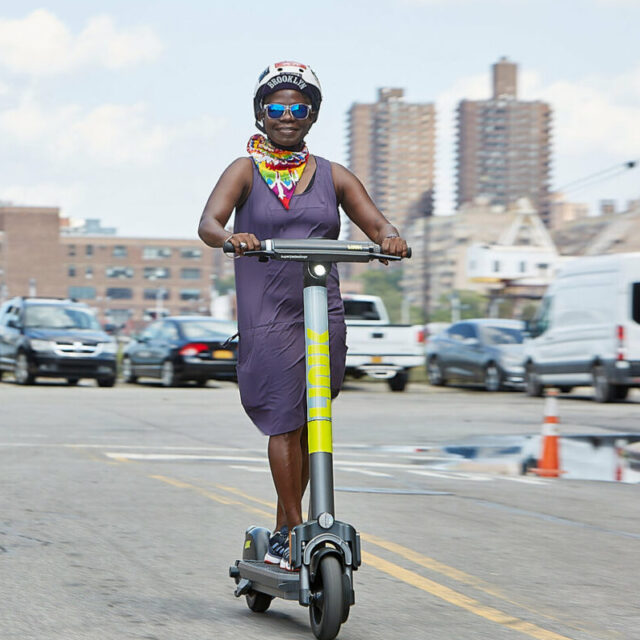
LINK by Superpedestrian are one of the four scooter operators in Seattle.
A lot of the issues that were introduced with a dockless system — namely, getting people to park correctly — remain today, although vendor fines and technological innovations (like requiring a photo of the parked vehicle to end a ride) have improved things. Seattle also introduced scooters late in the game, allowing it to learn from the experience of other cities. Importantly, all bike and scooter operators in the city are now required to offer low-income plans with discounts and set maximum pricing. Additionally, 10% of every operator’s fleet must be deployed in equity zones each day or risk being sanctioned.
“We have seen that the number of trip starts and ends have been a little lower in those [equity] zones, so there’s probably some work to do to make sure people have access and can actually use them,” says Edmonds. “Just because the bikes are there doesn’t necessarily mean it’s equitable. And then I think there’s a question about whether or not 10% is high enough.”
Edmonds says vendors are also required to work with SDOT on community outreach — outreach plans are a required component of each vendor’s bid before they’re selected. When it comes to education, outreach, and equity though, Edmonds admits that “there’s still always room to grow.”
The Better Bike Share Partnership is funded by The JPB Foundation as a collaboration between the City of Philadelphia, the National Association of City Transportation Officials (NACTO) and the PeopleForBikes Foundation to build equitable and replicable bike share systems. Follow us on Facebook, Twitter and Instagram or sign up for our weekly newsletter. Got a question or a story idea? Email kiran@peopleforbikes.org.



